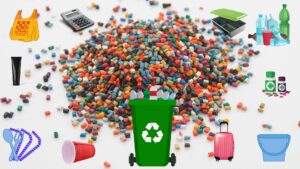India has a fascinating history with plastics that has led to a thriving plastics industry and a complex environmental issue. In Part 1 of this new series, we explore what exactly plastics are and where they come from.
 Plastics are everywhere. They linger on our roads, clutter our homes, and invade our bodies. In fact, the computer displaying this article is at least 30% plastic. One reason plastics are ubiquitous is that the term “plastics” includes hundreds of chemicals with qualities that vary from rock-hard to cotton-soft, liquid to solid, toxic to food-safe, etc. With such diversity among plastics, it can become hard to understand the many issues surrounding plastic manufacturing, use, and disposal. Before we tackle the big environmental questions, we revisit the fundamentals: what plastics are and where they come from.
Plastics are everywhere. They linger on our roads, clutter our homes, and invade our bodies. In fact, the computer displaying this article is at least 30% plastic. One reason plastics are ubiquitous is that the term “plastics” includes hundreds of chemicals with qualities that vary from rock-hard to cotton-soft, liquid to solid, toxic to food-safe, etc. With such diversity among plastics, it can become hard to understand the many issues surrounding plastic manufacturing, use, and disposal. Before we tackle the big environmental questions, we revisit the fundamentals: what plastics are and where they come from.
What are plastics?
“Plastic” describes any polymer that is synthesised in a lab and always contains both carbon and hydrogen. Using raw materials like coal, natural gas, crude oil, and salt, we can create polymers that can be further customised into plastics for specific purposes like making electronic devices, clothes, or food containers.
The raw materials needed to make plastics are extracted from the earth, mostly outside India, and heavily processed. For instance, India imports the majority of its crude oil from the Persian Gulf, Africa, and South America.
The crude oil is processed in industrial facilities called refineries. As a result of the processing, crude oil is fractionated into fuels, oils, and gases. Olefin gas, one such component of crude oil, is significant in plastic-making. Olefin is converted to pellets and sold to processing plants that fashion plastic from olefin pellets. Processing plants melt down the pellets and mould them into the products we commonly use. This processing stage is one of the most environmentally damaging in the lifecycle of plastics. Large amounts of toxic effluents are released directly into nearby lakes, rivers, and water channels causing irreversible damage to aquatic ecologies.
Ever wondered how plastics are created from crude oil and other raw materials? Check out this 1-minute video to find out!
Plastics we commonly use.
We can categorise plastics by how they handle heat: thermoset plastics and thermoplastics. Thermoset plastics are like potatoes. Once boiled, a potato cannot be unboiled. But the boiled potato can be used in hundreds of different recipes. For this characteristic of irreversibility, thermoset plastics are used where we need reliable coating or products that can withstand massive environmental changes. Wires and cables used for power distribution and telecommunications use thermoset plastics as insulation.
Thermoplastics, on the other hand, can be melted, moulded and remoulded endlessly without changing their definitive features. These mouldable thermoplastics become the plastic objects we use everyday.
Thermoplastics come in subtypes too. The thermoplastics used to make everyday products like plastic bottles, bags, cans, and toys are called commodity plastics. Single-use plastics, the biggest contributor to plastic pollution, are commodity plastics.
Commodity plastics are generally known by acronyms for their chemical names. Soft drink bottles are made from Polyethylene Terephthalate but are commonly known as PET bottles. There are six main types of commodity plastics, including PET, each with a set of unique characteristics we exploit to make everything from tape to toys.
Did you know?
Reliance Industries dominates the commodity plastic production in India, producing almost 42% of the products we use everyday. A close second is ONGC Petro Additions with a ~12% hold over India’s commodity plastics.
The mouldable thermoplastics are also used in making engineering and laboratory equipment like PVC pipes, safety glass, and nuts and bolts. This subtype of thermoplastics, called engineering plastics, are distinguished from commodity plastics by their higher hardiness, making them ideal for use in factories and laboratories.
Next, in The Story of India’s Plastics, we dive into how India consumes and uses plastics, and what this means in our fight against climate change. Read the second part here.
This article was edited and simplified by Upasana. The detailed article can be read here.
Centre for Financial Accountability is now on Telegram. Click here to join our Telegram channel and stay tuned to the latest updates and insights on the economy and finance.
